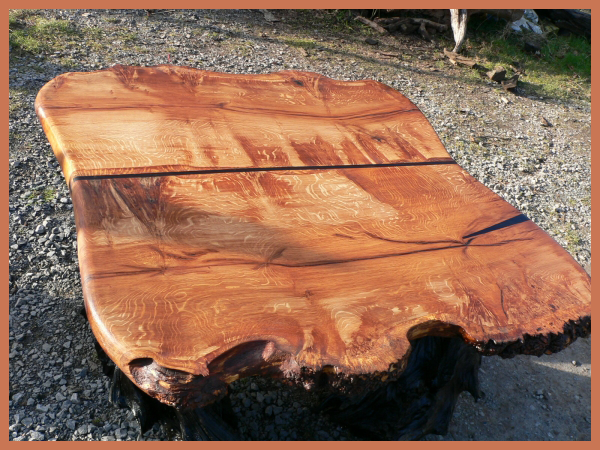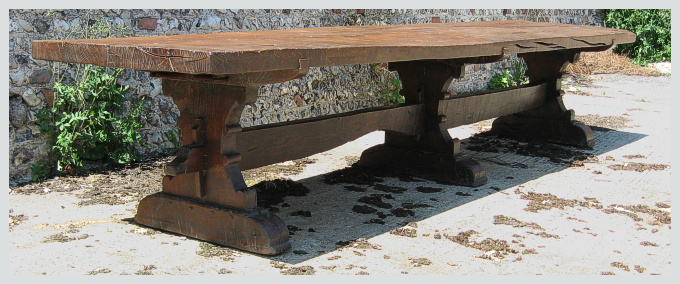Almost every household in the world has at least one and most people use them numerous times throughout the day. They come in a huge variety of designs and styles, can be made from a range of different materials and are used for all sorts of purposes. Yet despite its diversity and versatility, few people ever stop to consider the history of the humble table.
As old as civilisation itself
 For as long as humans have lived in dwellings, they have used elevated platforms on which to place their possessions. The earliest known tables date back to the 7th century BC and were little more than stone slabs. Indeed, the word table is derived from the Latin tabula, meaning board or plank.
For as long as humans have lived in dwellings, they have used elevated platforms on which to place their possessions. The earliest known tables date back to the 7th century BC and were little more than stone slabs. Indeed, the word table is derived from the Latin tabula, meaning board or plank.
Tables in these early days were not the formal pieces of furniture as we know them today, but small, portable platforms that rested across a person’s lap. They were often used for dining on, before being stored away when finished with. In Ancient Greek and Egyptian society, they were purely utilitarian objects made of wood or metal, and it wasn’t until the Roman period that they began to resemble the tables we have in our own houses.
More than just a piece of furniture
 During the Roman period, tables were seen as status symbols in the higher echelons of society. They often consisted of large pieces of cedar or walnut resting on bronze or ivory legs, which were sometimes carved into elaborate animal shapes. Tables were such prized possessions it is reputed that the philosopher Seneca had a collection of 500!
During the Roman period, tables were seen as status symbols in the higher echelons of society. They often consisted of large pieces of cedar or walnut resting on bronze or ivory legs, which were sometimes carved into elaborate animal shapes. Tables were such prized possessions it is reputed that the philosopher Seneca had a collection of 500!

The idea that the table represents more than just an item of furniture was not just applicable to the Romans. Medieval and Middle Ages rulers used large dining tables to entertain guests and display signs of their wealth and power. These tables were usually made of large slabs of elm or oak resting on a central support, and it wasn’t until the 16th century that advances in technology saw the table achieve a more diverse appearance.
Into the modern age
 As carpentry skills became more refined, simple tables became joined by things such as the draw-top table, which doubled the surface area of the table with extra leaves hidden under the top layer. In the 17th century, a trend developed for elaborate marquetry and veneers made from exotic wood, while the 18th century saw occasional tables introduced for specific social functions, such as dressing, writing or tea-drinking.
As carpentry skills became more refined, simple tables became joined by things such as the draw-top table, which doubled the surface area of the table with extra leaves hidden under the top layer. In the 17th century, a trend developed for elaborate marquetry and veneers made from exotic wood, while the 18th century saw occasional tables introduced for specific social functions, such as dressing, writing or tea-drinking.
Nowadays, the variety of outdoor furniture Brisbane is greater than ever. You can get tables made from wood, plastic, stainless steel, glass and a huge range of other materials. They come in a range of different designs and can be used for any purpose imaginable. Whether you buy yours from an antique dealer, a luxury furniture company like https://mavericklondon.co.uk/ or in flat-pack form, next time you sit at one to eat, work or play, stop and take a moment to consider the long history of the table and how your life would be different without them.
Author Graeme K: We were having the discussion of ‘who invented the wheel’ when someone made a similar reference to tables! Of course there is no exact claim or date as to when it first occurred, and perhaps it would always have been an eventuality, but it would be nice to know a rough inception time. We thought really it was when civilisations first occured and people lived among each other more. Of course today we just can’t do without them – we have stainless steel tables and oak tables in the same room where I work, each with diverse uses.






Wow, I definitely never considered the history of the table before now, fun to see how it evolved!;-)